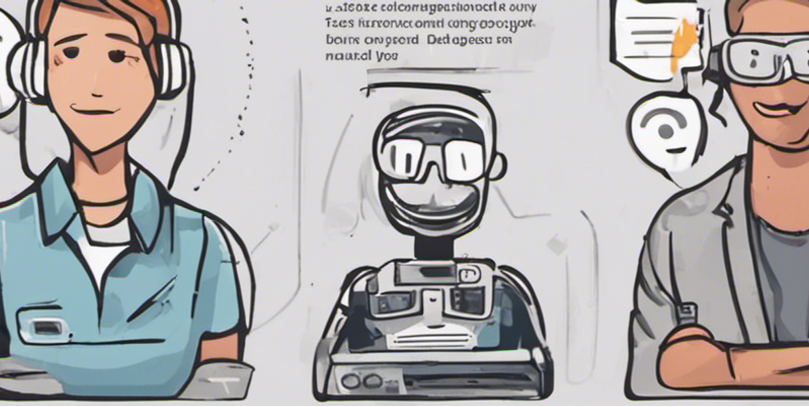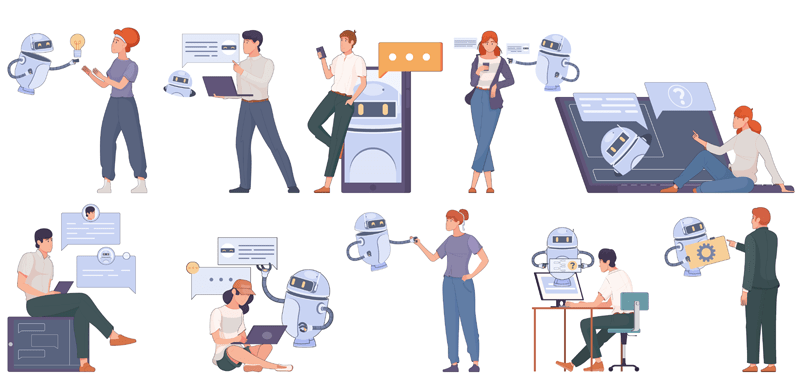
In the ever-evolving world of customer support, AI chatbots can now efficiently handle a staggering 85% of routine support queries.
This isn’t a glimpse into the future; it’s the present, as demonstrated by the remarkable success of the AI platforms.
From extending support services to a 24/7 operation to dramatically reducing response times, AI chatbot has set new standards in efficiency and customer satisfaction.
Take, for example, the integration of the Enrol AI chatbot with a fleet management software platform. This synergy led to autonomously handling 85% of customer support queries, freeing human agents up for more complex level 2 support tasks.
The results were nothing short of transformative – two out of three team members were reassigned to higher-level tasks, and response times for common issues like login assistance were slashed from 12 minutes to a mere 1 minute and 15 seconds.
Within five minutes, businesses can set up a highly intuitive chatbot, customisable in functionality and aesthetics.
Your AI chatbot isn’t limited to a single platform.
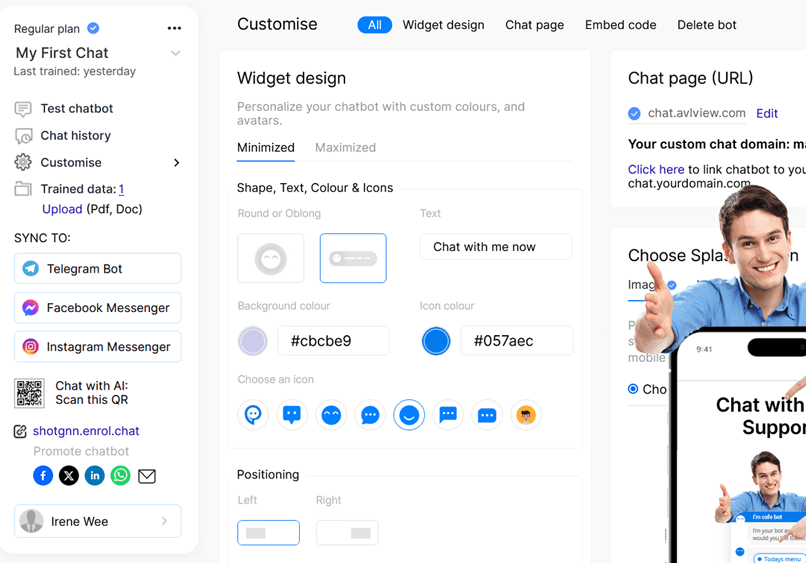
It’s accessible over the web through a QR code scan, website widget, and even on popular messaging platforms like Facebook Messenger and Telegram.
Each interaction allows businesses to grow, understand their customers better, and enhance their relationships while significantly reducing operational costs.
This guide is tailored for business owners seeking to enhance their support system, expand to round-the-clock service, and streamline their operations by reducing reliance on human support staff.
It is your comprehensive handbook to understanding, implementing, and mastering AI chatbot technology for unparalleled customer support and operational efficiency.
Through the lens of Enrol Chat’s success stories, this post aims to illustrate how any business can leverage AI chatbots for exceptional customer support and efficiency.
As we delve into the world of AI chatbots, we’ll explore not just the technicalities of implementation but also the tangible benefits, drawing on the success of Enrol AI to guide and inspire.
Understanding Chatbots
What Are Chatbots and Why Are They Important?
In simplest terms, chatbots are software applications designed to mimic human conversation.
Think of them as digital assistants that can interact with users via text or voice, handling a variety of tasks ranging from answering FAQs to guiding users through a website.
The real value of chatbots lies in their ability to automate routine interactions. This streamlines customer service processes and allows human staff to focus on more complex queries.

For example, a chatbot integrated into a customer service system can handle common questions like account queries or scheduling, which typically make up a large portion of customer interactions.
A key advantage of chatbots is their 24/7 availability.
Unlike human staff, they can operate around the clock, offering instant responses to user queries anytime.

This is particularly beneficial for businesses looking to provide continuous customer support without the overhead of 24/7 human staff.
Moreover, chatbots are scalable
They can handle an increasing volume of interactions without the need for additional resources.
This scalability is vital for growing businesses that experience fluctuating or increasing demands for customer service.

Another benefit of using chatbots is the data they can gather
Through interactions with users, chatbots can collect insights into customer preferences and behaviours, valuable information that can be used to tailor services and improve user experiences.

Chatbots are more than just automated responders
They are an integral part of an efficient customer service strategy, capable of enhancing user experience, providing valuable data insights, and ensuring continuous availability, all while streamlining operational efficiency.
Planning Your Chatbot Implementation
Preparing for Your Chatbot
“Business owners! Remember not to get bogged down by the routine. Automating the trivial with a chatbot can free you up to focus on what truly matters for your business’s growth.”
When considering the implementation of a chatbot like Enrol AI, businesses, especially those inundated with routine support requests, stand to benefit significantly.
Enrol AI serves many industries, especially those aiming to automate responses to regular queries – from password resets and FAQs to fetching business-specific info via API from your backend systems.
As a business owner, the key is to remember the importance of not getting bogged down in these routine tasks.
As the adage goes, “Don’t spend time beating on a wall, hoping to transform it into a door.” Automating these tasks frees up valuable time to focus on strategic growth.
Organise business documents

“An astonishing 78% of businesses don’t have their essential information consolidated.”
The most significant consideration in this phase is the organisation and readiness of business-specific documents.
Implementing a chatbot like Enrol AI serves as a catalyst for businesses to collate and organise their data, a critical step for the chatbot’s effectiveness and overall operational efficiency.
Setting it up
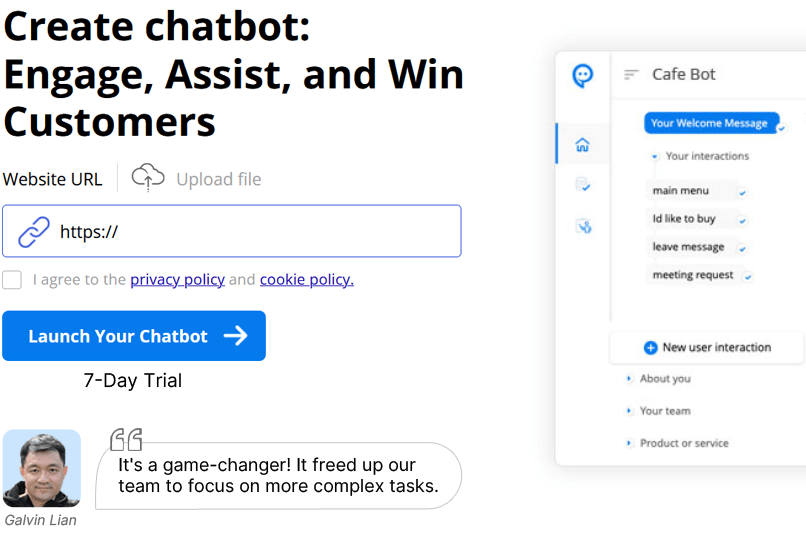
Setting up Enrol AI is remarkably straightforward.
Businesses can start by visiting the Enrol website, entering their URL, or uploading documents related to their services.
Within five minutes, the AI chatbot is ready for deployment, accessible via a web URL. This simplicity in setup ensures that businesses can quickly transition to using AI support without extensive technical know-how.
Customise and Train
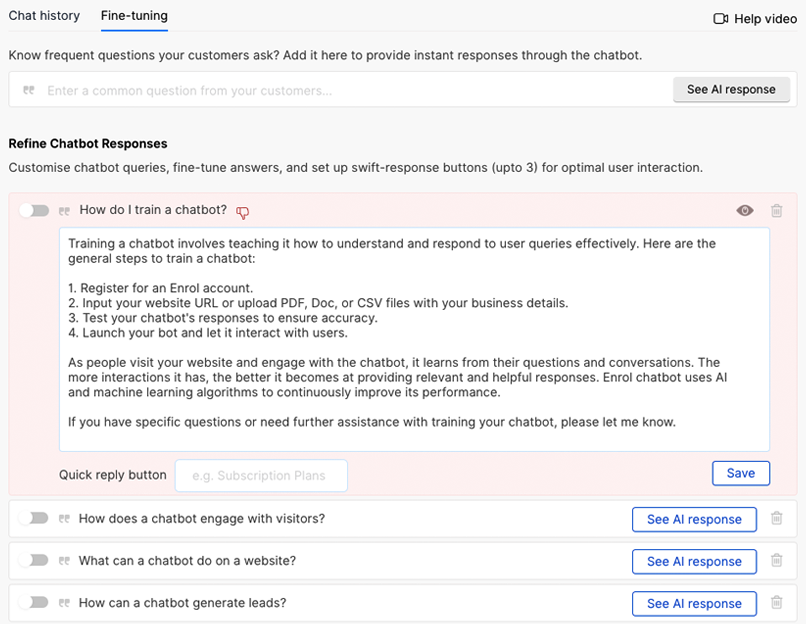
Tailoring the chatbot to reflect the business’s theme and operational needs is crucial to the setup.
Businesses often customise their chatbots to align with their branding, and as they grow, they train the bot with more data specific to their operations.
Features like quick reply buttons, appointment scheduling integrations, and refined responses are commonly added to enhance functionality.
Success Factors
Successful implementation often begins with the business owners taking the time to compile comprehensive documentation about their services or products.
The richness of the chatbot’s knowledge base directly correlates with its effectiveness and customer satisfaction.
An innovative approach seen among successful adopters of Enrol AI is using QR codes linked to the chatbot on marketing materials and business cards, significantly enhancing customer and prospect engagement.
In summary, planning for AI implementation involves a straightforward setup process, thoughtful customisation, and strategic data organisation.
The simplicity and efficacy of Enrol AI not only transform customer support operations but also encourage a more structured and data-driven approach to business management.
Designing Your Chatbot
Your User-Friendly Chatbot
Designing a chatbot isn’t just about making it functional; it’s about creating an experience that resonates with users.
Widget Design
The journey begins with customising the chat widget on your webpage.
The appearance, from shape to colours, sets the initial tone for user interaction.
You may choose between round or oblong icons and personalise the greeting text. This customisation extends to the main chat window, allowing you to align the design with your brand’s aesthetic to the chat timestamp and bot avatar.
Chat URL and Custom Subdomain
Your AI chatbot goes beyond your website.
The web chat version of the chatbot plays a pivotal role in delivering a seamless experience.

How about making it easy for people to reach your chatbot on their phones?
So publish your bot online via a custom subdomain, like ‘yourname.enrol.chat’. For those on the advanced plan, there’s even the option to use a domain-specific URL, such as ‘chat.yourdomain.com’, enhancing brand consistency.
It is just a scan or click away on mobile devices.
Customers just scan a QR code and chat with your AI bot from their mobile browser.
When accessed on mobile, the AI chat unfolds into a landing page-like experience for the user, customisable with images, webpages, or videos to create a more engaging and personalised interaction.
It’s not just about providing information; it’s about engaging your audience with interactive features like ‘Start Chat’, ‘Book Meeting’, or ‘Request Callback’.
Gathering leads is crucial for follow-up.
Your AI bot allows you to collect names, mobile numbers, and emails, with the flexibility to tailor what data you gather depending on your business needs.
Streamline your appointment scheduling by integrating your chatbot with Google Calendar.
Show available slots and confirm bookings directly through the chat, simplifying the process for you and your customers.
First impressions matter…
The animated GIF greetings set a friendly tone, while quick reply buttons offer users immediate answers to common queries. This combination of personalisation and efficiency makes the chat experience engaging and helpful.

Make it adaptable …
Businesses can tailor chat responses, integrate with back-end systems for real-time data fetching, and even train the chatbot with business-specific documents.
This level of customisation ensures that the chatbot aligns perfectly with both your operational needs and your brand voice.
Feedback is key in refining the chatbot experience.
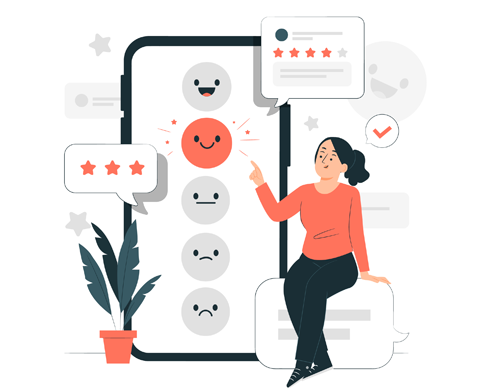
The design allows for ongoing adjustments based on user interactions and feedback, ensuring that the chatbot evolves with your business and continues to meet your customers’ needs effectively.
Designing a chatbot means creating a tool that’s smart and efficient and a true representative of your brand, capable of engaging customers in meaningful and productive interactions.
Technical Aspects of Chatbot Implementation
Building and Integrating
Implementing a chatbot into your business operations is a strategic move towards enhancing efficiency and customer engagement. With platforms like Enrol, this process is simplified, making it accessible even to those with basic technical skills.
Building Your Chatbot: Step-by-Step
To start making an AI chatbot with Enrol, go to https://enrol.chat. Then, you add your business information by sharing your website or uploading documents in PDF or Excel format.
The above step is crucial as it lays the foundation for your chatbot’s understanding and response capabilities.
Following this, a straightforward registration with your name and email leads to selecting relevant web pages from your site if you opt for the former.
The platform then takes over, training the chatbot with the provided information.
Upon completion, you’re presented with a web URL for the chatbot, a QR code, and an embeddable JavaScript code for integrating the chat widget on your website.
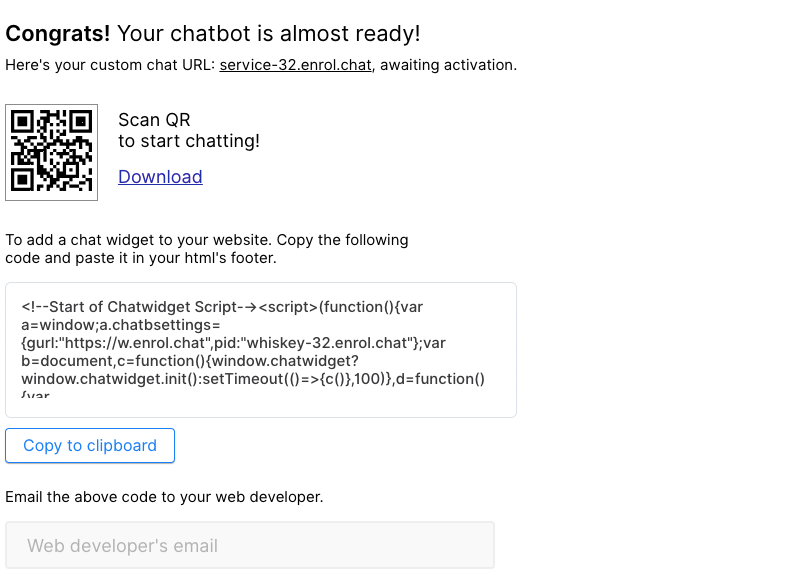
The final customisation step involves defining your business name, the product or service focus, and the chatbot’s intended role, sales, support, or a general AI assistant.
Connect Your Chatbot to Backend Systems Using API
Enrol eases the integration process with existing business systems through its API offerings.
These APIs allow for seamless connection with backend systems, ensuring the chatbot can access and provide relevant information.
The platform offers a selection of up to nine segments under its regular plan, with custom plans available for more extensive requirements.
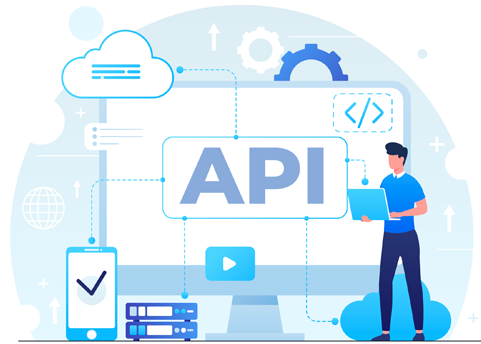
Emphasise the responsible use of AI.
This responsibility is critical to handling personally identifiable information (PII). Businesses integrating Enrol must be aware of and adhere to the ethical considerations and legal requirements regarding PII, ensuring user consent is obtained wherever necessary.
In summary, the technical implementation of a chatbot with Enrol is designed to be user-friendly, flexible, and supportive, catering to basic needs and more complex integrations, all while upholding ethical standards in AI usage.
Recognising the challenges of new technology, Enrol provides robust technical support and comprehensive documentation to assist users throughout the development and integration process. They are committed to going the extra mile to deliver results and even consider additional feature requests that can add value to their user base.
For businesses requiring more advanced custom development, such as adding custom code or integrating complex workflows, Enrol is open to assessing feasibility upon request. This flexibility allows businesses to tailor the chatbot to their specific operational needs.
Testing and Launching Your Chatbot
Key Insights and Takeaways
The journey from chatbot development to its successful deployment is crucial. Enrol’s approach to testing and launching offers valuable insights into ensuring a chatbot is ready for action and effective post-launch.
Test your AI bot
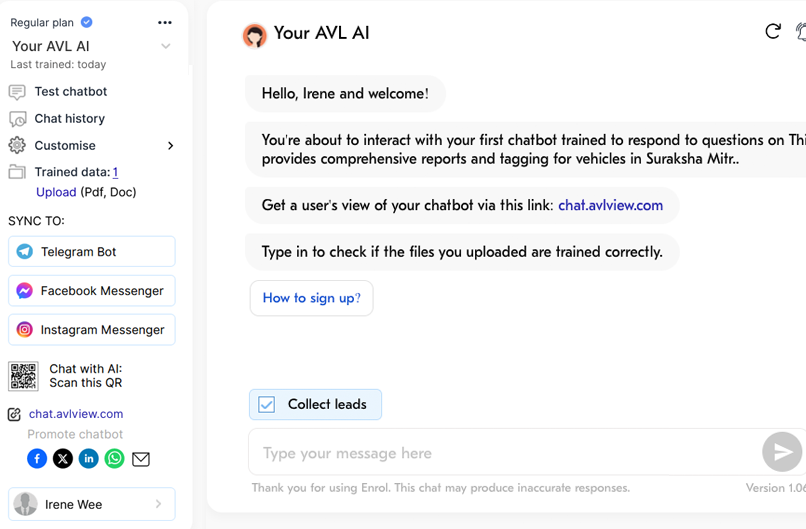
Testing is the first critical step after creating your chatbot. Enrol encourages users to rigorously test the chatbot by asking business-relevant questions, ensuring it is well-trained in the business knowledge base.
This phase is essential for assessing the chatbot’s understanding and response accuracy.
Spotting and Fixing Chat Responses
During testing, users can easily identify and mark inaccurate responses or need refinement using a simple thumbs-down icon.
These flagged responses can be fine-tuned on a dedicated page. The chatbot then relearns from this updated content, enhancing its accuracy and reliability.
Listen to User Feedback
Incorporating user feedback is integral to refining a chatbot’s performance. Enrol’s system allows for ongoing fine-tuning based on user interactions.
This iterative process ensures that the chatbot continuously evolves and improves its response quality.
Plan for Rollout
Once the chatbot passes the testing phase, it’s time to introduce it to the world.
Enrol recommends leveraging social media platforms like Facebook, Twitter, LinkedIn, and WhatsApp to share the chatbot URL. This strategy promotes the chatbot and encourages user engagement right from the start.
Track and Update After Launch
After launch, the monitoring phase is crucial. Enrol maintains up to 90 days of chat history, enabling users to review all interactions and leads generated.
This monitoring is vital for identifying areas where the chatbot may require further refinements. Regularly updating the chatbot based on these insights ensures it remains effective and continues to meet user needs.
In essence, the transition from testing to launching a chatbot is a process of continuous improvement and adaptation.
By rigorously testing, incorporating user feedback, strategically launching, and constantly monitoring performance, businesses can ensure their chatbot remains an effective and dynamic tool for engaging with customers.
Best Practices in Chatbot Implementation
Best Practices from Enrol’s Success
Implementing a chatbot effectively involves more than just setting it up; it’s about continuously refining and aligning it with your business needs and customer expectations.
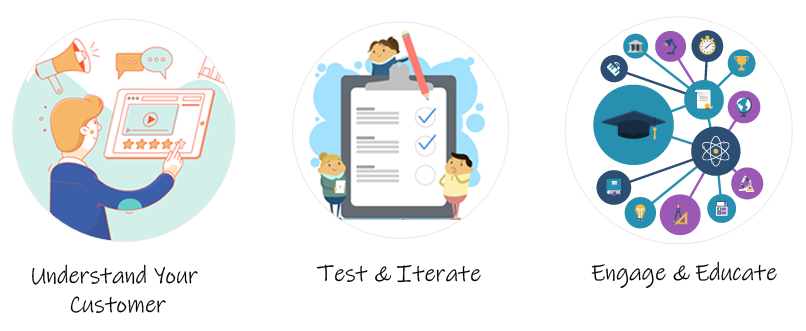
Here are some best practices derived from Enrol’s approach:
Initiate customer profile analysis and utilise user data, including past interactions and preferences, to customise responses and suggestions.
Tailor recommendations by observing user behaviour on the website or app, such as pages visited and items clicked. Offer personalised interactions based on user behaviour and history. Personalised greetings, recommendations, and responses make customers feel understood and valued.
Let the chatbot learn from each interaction, refining its understanding of user preferences for future conversations. Employ large language models to understand user queries accurately, ensuring contextually relevant responses.
Analyse the tone and sentiment of user messages to adjust responses, ensuring empathetic communication.
Personalise service with CRM systems to access detailed customer histories.
Set up conversation paths based on typical customer profiles for a more personalised interaction experience.
Handle Complex Queries. While Enrol doesn’t have a direct escalation process, it empowers users to regularly monitor historical chat data and refine answers to improve the chatbot’s handling of complex queries.
Encourage updating the chatbot’s knowledge base periodically, adding more content to ensure the AI learns and responds more accurately in future interactions.
Utilise user feedback to adapt and refine the chatbot’s communication patterns, ensuring a cycle of continuous improvement.
Ensure API compatibility with standards like OpenAPI version 3.0 for seamless integration with existing business systems.
Adhere strictly to data protection laws like Singapore’s personal data protection laws and GDPR to ensure compliance and maintain user trust.
By following these best practices, businesses can ensure their chatbot responds accurately and provides a personalised and empathetic user experience while continuously learning and adapting to user needs and feedback.
This approach to chatbot implementation fosters a more dynamic and effective customer interaction platform.
Best Practices Customer Interaction and Engagement
The ability to provide support and answers anytime, even outside of regular business hours, significantly enhances customer satisfaction.
It is based on a large language model that allows the chatbot to understand and respond to a wide range of queries more accurately, making interactions more human-like and less robotic.
Seamless integration with business systems (like CRM and ERP) and platforms (such as Google Calendar, Facebook Messenger, and Telegram) allows for streamlined processes and provides customers with a cohesive experience
Initiating conversations based on user behaviour on the site, such as offering assistance when a customer seems to be struggling with a purchase decision.
A user-friendly interface makes it easy for customers to navigate and interact with the chatbot, enhancing the overall experience.
Incorporating a system for users to provide feedback on their chatbot experience helps in continuous improvement. Catering to customers in their native language broadens the appeal and accessibility of the chatbot.
Quick responses to inquiries and efficient handling of routine tasks reduce customer effort and increase satisfaction. Ensuring customer data is handled securely and in compliance with privacy laws builds trust.
Allowing businesses to tailor the chatbot’s responses and conversation flows to match their brand tone and specific customer needs.
Optimising the chatbot for mobile devices ensures a smooth experience for customers on the go.
Future Trends and Roadmap
The Future of AI Chatbots
As the landscape of chatbot technology continues to evolve rapidly, staying ahead of emerging trends is crucial for maintaining relevance and effectiveness.
Enrol is positioning itself to keep pace with these trends and be a forerunner in shaping the future of chatbot technology.
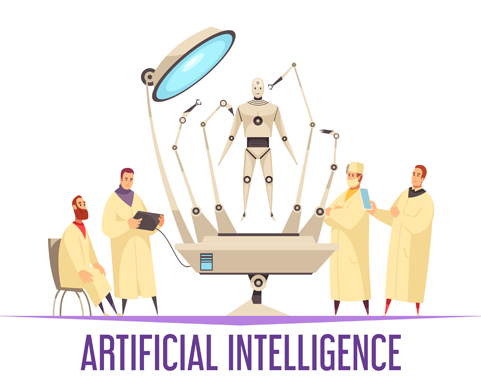
The trend toward ultra-realistic AI responses is gaining momentum, and Enrol is focusing on enhancing its AI to deliver more human-like interactions.
This involves refining natural language processing capabilities and improving integration with social media and tools like CRM systems.
These enhancements are geared towards creating more personalised and context-aware interactions, aligning with the trend of offering deeply customised user experiences.
Future Developments and Innovations
Enrol is set to expand its offerings with custom web and video landing pages.
The upcoming feature of tracking visitors and presenting them with customised pop-outs based on their intent marks a significant leap towards advanced personalisation.
This move aligns with the trend of predictive and intent-based personalisation, where chatbots anticipate user needs and preferences to offer tailored content and interactions.
Long-Term Vision: Enrol envisions itself as an AI launchpad for small to medium businesses, transforming how these entities utilise AI for customer interaction and support.
The long-term goal is to create an ecosystem of integrated AI tools that empower businesses to automate a significant portion of their regular support requests, thereby enhancing efficiency and customer satisfaction.
Industry-Specific Solutions: Acknowledging the diverse needs across different industries.
The focus is on enabling companies to automate up to 90% of their regular support interactions, a goal that transcends industry boundaries and offers universal value.
In conclusion, Enrol’s roadmap is intricately aligned with the future trajectory of chatbot technology.
By focusing on realistic AI responses, advanced personalisation, and industry-agnostic solutions, It is poised to adapt to future trends and pioneer new advancements in the realm of chatbot technology, reinforcing its role as an indispensable AI tool for businesses.
Conclusion
As explored throughout this post, the implementation and optimisation of chatbots represent a significant stride in enhancing customer engagement and operational efficiency. Enrol AI Chat stands out as a paragon in this domain, exemplifying best practices across various aspects of chatbot technology.
From the initial setup, which is streamlined and user-friendly, to the intricate personalisation and integration capabilities, the chat platform demonstrates the potential of chatbots when correctly implemented.
Based on user interactions and feedback, the platform’s commitment to continuous learning and adaptation ensures that each chatbot evolves to meet changing customer needs and preferences.
Furthermore, Enrol’s approach to handling complex queries and its vision for future trends in AI chatbots underline its role as a leader in this technology space.
The roadmap, focusing on making AI responses more human-like and its innovative features like custom web and video landing pages, underscores the platform’s dedication to staying at the forefront of chatbot technology.
This commitment enhances the user experience and empowers businesses, especially small to medium-sized ones, to effectively leverage AI for customer support and engagement.
If you want to elevate your customer support system, reduce operational costs, and stay ahead in the digital landscape, consider Enrol AI as your chatbot solution.
Visit Enrol’s website or reach out for a demo to see how Enrol can transform your customer interaction and support systems.
In an era where efficiency and customer engagement are paramount, embracing advanced technologies like Enrol AI is not just an option; it’s a strategic imperative for business success.

